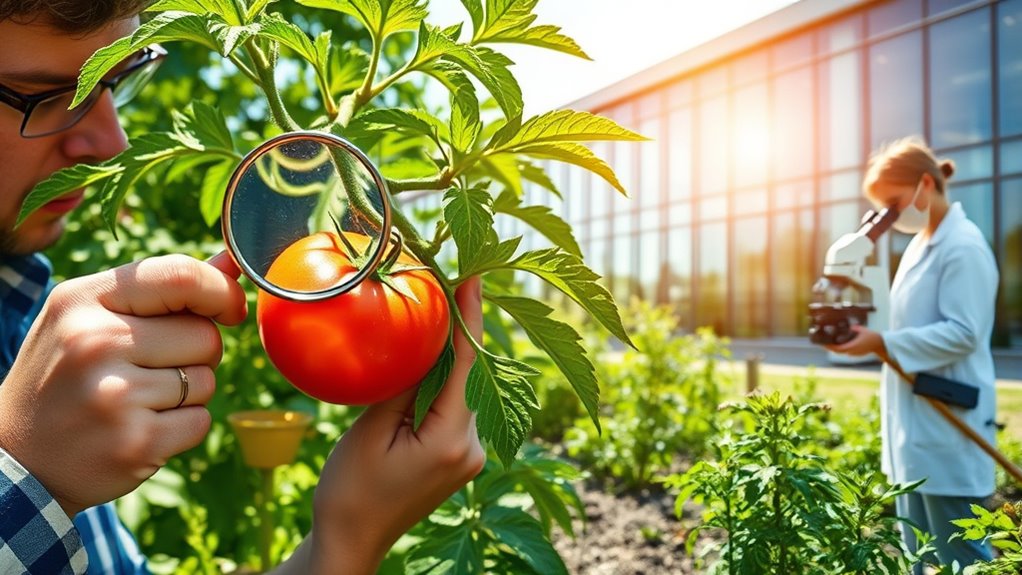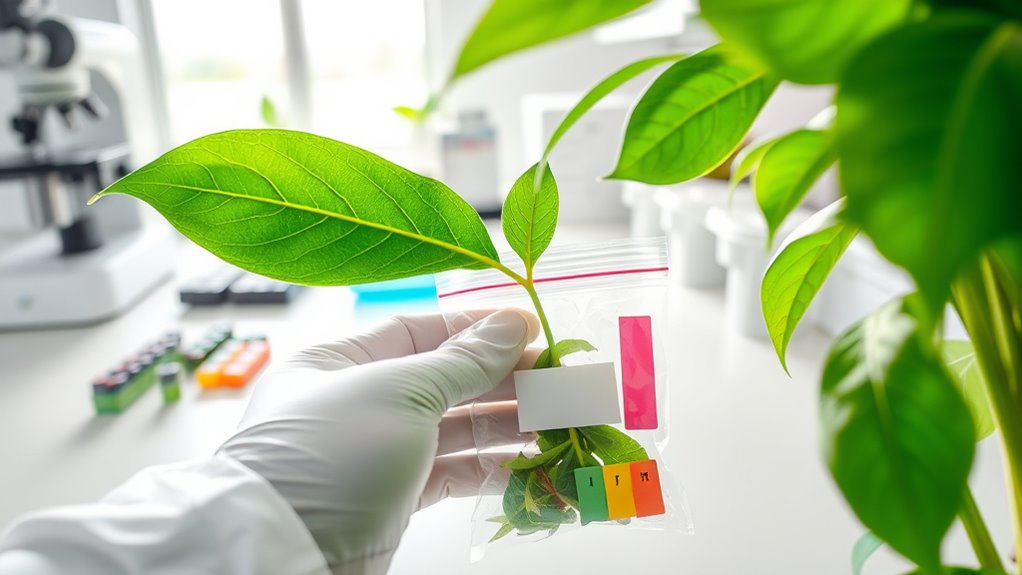To use plant clinic services and extension labs, start by identifying early signs of problems like discoloration or wilting. Collect clean, representative samples from affected plants and label them carefully. Contact your local extension office or visit their website to find out how to submit samples or arrange a consultation. Once results are available, follow expert recommendations to treat pests, diseases, or soil issues. Keep exploring for more tips on effectively maintaining healthy plants.
Key Takeaways
- Locate your local extension or plant clinic through state or county university websites or agricultural directories.
- Collect and prepare representative, clean samples of affected plants following proper sampling techniques.
- Contact the extension or plant clinic to schedule a consultation and provide detailed plant and symptom information.
- Submit samples as per provided instructions, ensuring they are labeled accurately and maintained properly during transport.
- Use the clinic’s diagnostic results and recommendations promptly to implement appropriate pest, disease, or soil management actions.
Understanding the Services Offered by Plant Clinics and Extension Labs

Plant clinics and extension labs provide essential services to help you manage plant health effectively. When you visit, experts assist with plant disease and pest identification, so you can understand what’s affecting your plants. They analyze samples you bring in, such as leaves, stems, or insects, to pinpoint specific issues. This helps you determine the cause of problems and find appropriate solutions. These services are designed to give you reliable, science-based advice without guesswork. Whether you’re dealing with a mysterious spot on a tomato or pests damaging your vegetables, staff can guide you through the next steps. By utilizing these clinics, you gain access to expert knowledge that supports healthy, productive plants and prevents issues from worsening. Supporting plant health is a key goal of these services, helping you maintain vibrant, thriving gardens.
Identifying Plant Health Issues and When to Seek Help

Recognizing early signs of plant health issues is essential to preventing minor problems from becoming severe. Look for discoloration, wilting, or unusual spots on leaves, which can indicate problems like nutrient deficiencies or pest infestations. Soil testing can reveal imbalances or deficiencies that weaken plants and make them more susceptible to pests or diseases. If you notice pests or damage, timely pest identification helps determine the appropriate treatment. When symptoms persist or worsen despite basic care, it’s time to seek help from a plant clinic or extension lab. Experts can provide accurate diagnoses and recommend effective solutions. Spotting issues early enables you to take action promptly, saving your plants and avoiding costly damage later. Additionally, understanding the importance of color accuracy in your plant diagnostics can improve the clarity of visual assessments, leading to more precise identification of issues.
Locating Your Local Plant Clinic or Extension Laboratory

Finding your local plant clinic or extension laboratory is a straightforward process. Start by visiting your state or county university extension website, which often lists nearby clinics and labs. These facilities can assist with pest identification and guidance on soil amendments, helping you improve plant health. You can also call local agriculture offices or check agricultural directories for contact information. Many clinics offer expert advice on managing pests and choosing the right soil amendments to enhance soil quality. Additionally, community gardening groups or local horticultural societies may have recommendations for trusted labs and clinics in your area. Once you’ve located your nearest facility, you’ll be ready to seek expert help when issues arise, ensuring healthier plants and more productive gardening or farming. It’s also helpful to understand soil testing methods to better interpret the results provided by extension labs.
Preparing Samples for Testing or Diagnosis

Preparing your samples correctly is essential to guarantee accurate diagnosis and effective treatment. Proper preparation ensures soil testing results are reliable and pest identification is accurate. To do this:
- Collect fresh, representative samples from the affected area, avoiding contamination.
- For soil testing, take samples from multiple spots, mix them thoroughly, and place a small amount in a clean, labeled container.
- When submitting pest samples, include both live insects and affected plant parts if possible, keeping them in sealed containers.
- Ensure samples are dry and free of dirt or debris, and label everything clearly with date and location details.
- Incorporate sampling techniques that follow best practices for your specific tests to improve accuracy.
Following these steps helps extension labs provide precise results, leading to better pest management and soil health strategies.
How to Submit a Sample or Request a Consultation

When submitting a sample or requesting a consultation, make certain your sample is properly prepared to guarantee accurate results. Clearly communicate your concerns and provide all necessary documentation to help the clinic understand your situation. Following these steps will make the process smoother and more effective. Additionally, ensure your sample includes nutrient-rich ingredients to facilitate comprehensive analysis.
Preparing Your Sample
To guarantee your plant issue is accurately diagnosed, it’s essential to collect and submit a well-prepared sample. Proper preparation ensures reliable results like soil testing or pest identification. Follow these steps:
- Collect fresh, representative samples from affected areas, including soil, plant tissue, or pests.
- Use clean tools and containers to prevent contamination.
- Label samples clearly with your name, contact info, and details about the problem.
- Keep samples cool and dry during transport, avoiding exposure to extreme temperatures.
- Ensure samples are free from cross-contamination to maintain the integrity of the analysis.
Requesting a Consultation
Wondering how to submit your sample or request a consultation? To get started, contact your local extension office or plant clinic to schedule a consultation. Explain your concerns about a possible plant disease and describe the symptoms you’ve observed. They’ll help you set up a convenient consultation time and guide you through the sampling process if needed. Be prepared to provide details about your plant, such as species, location, and any treatments applied. Once your appointment is scheduled, follow any instructions provided for submitting your sample or discussing your plant health issue. Remember, clear communication and timely scheduling ensure the expert can diagnose the plant disease accurately and recommend effective management strategies. Cultivating attention during your consultation can lead to more precise diagnoses and better outcomes.
Submitting Proper Documentation
Submitting proper documentation is essential to guarantee your plant issue is accurately diagnosed. Clear sample documentation helps lab staff understand your problem quickly and accurately. Follow these submission guidelines to ensure your request is processed smoothly:
- Include detailed descriptions of symptoms and plant history.
- Label your sample clearly with your name, contact info, and plant details.
- Pack the sample securely to prevent damage during transport.
- Follow specific submission guidelines provided by the clinic or extension lab.
- Using proper documentation reduces the risk of misdiagnosis and ensures an efficient diagnostic process.
Adhering to these steps improves the chances of a precise diagnosis. Proper sample documentation reduces delays and unnecessary repeat submissions. Always review the submission guidelines beforehand to confirm you’ve included all necessary information, making the diagnostic process efficient and effective.
Interpreting Diagnostic Results and Recommendations

When you receive diagnostic results from a plant clinic, understanding what they mean is essential for effective action. Accurate result interpretation depends on your ability to connect laboratory findings with your plant’s symptoms and history. Keep in mind that diagnostic accuracy can vary, so consider the context of the results carefully. Look for clear explanations and recommendations provided by the clinic, and don’t hesitate to ask questions if something isn’t clear. Focus on the key issues identified, such as specific pests, diseases, or environmental factors. Remember, the goal is to use this information to make informed decisions about treatment or management, ensuring your plants recover and thrive. Clear interpretation is crucial to implementing the right next steps effectively. Utilizing diagnostic tools and resources can further enhance your understanding of the results.
Implementing Advice and Follow-Up Actions

Once you have received and understood the diagnostic results and recommendations from the plant clinic, the next step is to implement the advised actions promptly and carefully. Focus on improving soil health and pest management to support plant recovery. Here’s how to proceed:
- Amend your soil based on suggested practices, such as adding organic matter or adjusting pH levels.
- Apply pest control measures recommended, like targeted biological controls or safe chemical treatments.
- Remove and dispose of infected plant material to prevent pest spread and disease recurrence.
- Monitor plant responses regularly, noting any changes in pest activity or soil conditions.
Taking these steps ensures your plants recover efficiently, and soil health is restored, reducing future problems and maintaining healthy growth.
Tips for Maintaining Plant Health and Preventing Future Problems

To keep your plants healthy and prevent future issues, regular maintenance and proactive practices are essential. Start by improving soil health with appropriate soil amendments, which enhance nutrient availability and structure. Healthy soil supports strong plants and reduces vulnerability to pests and diseases. Practice consistent pest management by inspecting plants regularly and removing pests early. Keep an eye out for signs of stress or disease, and address problems promptly. Guarantee proper watering, pruning, and fertilization to promote vigorous growth. Mulching can help retain moisture and suppress weeds, reducing pest habitats. Additionally, understanding plant health and care can further improve your plant maintenance routine. By staying proactive and attentive, you minimize the risk of future problems and create a resilient environment for your plants to thrive.
Frequently Asked Questions
Are There Fees for Using Plant Clinic Services or Extension Labs?
You might wonder if there are service fees or appointment costs when using plant clinic services or extension labs. Typically, many clinics offer free consultations or have minimal fees for analysis, but it varies by location. It’s best to check with your local clinic beforehand to understand any potential service fees or appointment costs. This way, you can plan accordingly and make sure you get the help you need without surprises.
Can I Access Online Consultations or Only In-Person Visits?
Did you know over 60% of plant clinics now offer virtual consultations? You can access expert advice through virtual consultations, making it easier to get help without leaving home. Many clinics also offer mobile sampling, so you can get your plants tested on-site or send samples remotely. Whether in-person or online, these options guarantee you get the support you need to keep your plants healthy.
What Types of Plants or Issues Are Covered by These Services?
You can access Plant Clinic services for a wide range of plants and issues, including plant disease identification and pest management strategies. Whether you’re dealing with fungal infections, insect infestations, or other plant health concerns, these services cover many common and complex problems. They help identify problems accurately and recommend effective solutions, ensuring your plants stay healthy. In-person visits are typical, but some clinics may also offer online consultations for convenience.
How Long Does It Typically Take to Receive Diagnostic Results?
Think of your sample turnaround as a relay race—fast but careful. Usually, your diagnostic timeline takes about one to two weeks, depending on the complexity of the issue and the lab’s workload. You’ll get updates along the way, and once your sample reaches the top of the queue, results come back promptly. Patience pays off, and you’ll soon have the info needed to tackle your plant problem effectively.
Are There Any Restrictions on Sample Size or Quantity?
When submitting samples, you might wonder about sample submission and quantity limitations. Generally, there are restrictions on sample size and quantity to guarantee accurate testing and efficient processing. You should check specific guidelines provided by the clinic or lab, as these limitations vary depending on the type of sample and testing required. Following these restrictions helps avoid delays and ensures your samples are handled correctly.
Conclusion
By reaching out to your local plant clinic or extension lab, you open the door to expert guidance that can gently steer your garden back on track. With their help, you’ll learn to recognize subtle signs of trouble and nurture your plants with confidence. Remember, every healthy plant starts with a little patience and the right support—think of these services as friendly hands guiding you toward a lush, thriving garden you can be proud of.









